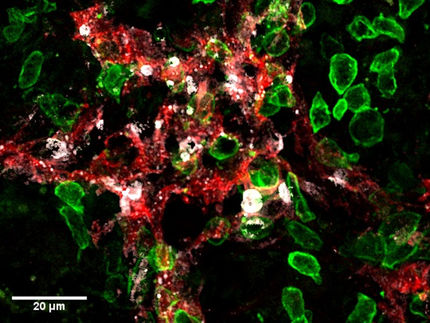New function for a well-known immune messenger molecule
The molecule interleukin-7 (IL-7) is an important immune messenger protein which ensures that a sufficient number of T cells are present in our body for immune defence. Researchers from ETH Zurich have now demonstrated that IL-7 has another important function: it enhances the drainage function of lymphatic vessels, which collect fluid that has leaked out of blood vessels into the body tissue and return it to the bloodstream. In the future, this finding could become useful for lymphedema patients, whose lymphatic drainage system does not work properly, resulting in fluid accumulation and tissue swelling.
The predisposition to develop lymphedema may, on one hand, be hereditary. On the other hand, lymphedema often occurs in the aftermath of a tumour surgery. When primary tumours are surgically excised, tumour-draining lymph nodes are often removed as well, as they may contain tumour cell metastases. In the course of such surgical interventions, the lymphatic tissue is damaged. As a result, tissue fluid can often no longer be drained properly, leading to the occurrence of lymphedema in 20 to 30 per cent of patients.
No drug treatment yet
Currently, the only treatment options for lymphedema patients are wearing compression garments and undergoing manual lymph drainage by a medical massage therapist. "In IL-7, we have discovered a molecule and a mechanism for enhancing lymphatic drainage which could potentially be useful for lymphedema therapy," says the head of the study Cornelia Halin, Assistant Professor of Drug Discovery Technologies.
In their study, the researchers found that IL-7 is produced by the so-called endothelial cells, which form the lymphatic vessel wall. These cells also express the receptors that specifically recognise IL-7 based on the lock-and-key principle. "Although we have not formally proven it so far, we assume that the lymphatic endothelial cells produce the messenger substance so that it can affect their own function directly," says Halin. So far, IL-7 is one out of only few molecules that have been identified to support lymphatic drainage. A few years ago, other researchers discovered that the endogenous growth factor VEGF-C might also be an interesting molecule in this regard.
Insights from an animal model
Halin and her colleagues demonstrated the drainage-supporting function of IL-7 by performing drainage experiments in mice where they injected a blue, albumin-binding dye into the ear skin of the mice. Notably, albumin is an endogenous protein, which can only be transported out of the tissue via the lymphatic vessels. By quantifying the dye that remained in the tissue one day after the injection, the researchers were able to determine how well the lymphatic drainage worked in these laboratory animals.
When performing this experiment in mice lacking a functioning IL-7 receptor, they observed that these mice were only able to remove half as much dye from their ear skin in comparison with mice possessing a functional IL-7 receptor. By contrast, they observed a considerable increase in lymphatic drainage in mice with increased IL-7 production. Finally, in a third experiment, they administered IL-7 protein to unmodified, healthy mice and observed that this therapeutic treatment led to an improvement of lymphatic drainage function.
Already tested in patients
The scientists are now planning to conduct similar experiments in mice in which lymphatic vessels have been surgically destroyed, similarly to the situation found in patients after cancer surgery. Here, the researchers would like to test whether treatment with IL-7 could help to prevent lymphedema or whether IL-7 could even be administered in order to reduce existing lymphedema.
The long-term goal is to explore the potential of an IL-7-based medication for lymphedema. Notably, IL-7 is already being tested in clinical trials, albeit for different indications: because of its immune-stimulatory activity on T cells, IL-7 is currently being tested in patients with immunodeficiency diseases, such as HIV, or hepatitis infections, or who have undergone bone-marrow transplantations.






















































